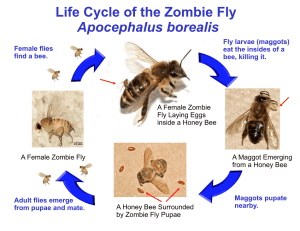You may remember hearing in the news a while back about the appearance of zombie bees along the west coast of the United States. No, the zombie bees aren’t a result from a bio experiment gone wrong, but are honey bees being parasitized by Apocephalus borealis aka the zombie fly.

The female fly finds a honey bee (most likely a worker), attaches, and then injects eggs into her abdomen. The eggs hatch into larvae which use the bee as a food source, consuming her organs and other tissues as they mature. During this process the honey bee displays unusual behaviors including flying at night and attraction to nearby lighting. Eventually the honey bee does not return from her nightly flight and dies. Honey bees parasitized by Apocephalus borealis are usually found at the base of a lamppost, porch light, or other outdoor lighting. The larvae emerge from her abdomen after they have finished consuming her and then form into pupae which eventually hatch into adult zombie flies. If this hasn’t disturbed you yet, this fact will: as many as 15 larvae can emerge from a single honey bee!

I’ve recently discovered a citizen science project called the Zombee Watch which is striving to determine where in North America the zombie fly is parasitizing honey bees. Check out the website at https://www.zombeewatch.org/ San Francisco State researchers are urging beekeepers to become zombee hunters and then submit their findings. It includes a detailed tutorial explaining how to create a variety of zombie honey bee traps including a fairly inexpensive one made out of a juice bottle and a safety light holder. Rob Snyder of the CA Tech Team actually blogged about this subject and how he built a trap last year (click here to go to his blog).

On the front page there is a map showing the locations of confirmed honey bee parasitism by Apocephalus borealis to date. So far it seems like the majority of zombee outbreaks are along the pacific coast, particularly Washington State and California. This is especially interesting because Apocephalus borealis has been identified in several locations across the country yet there are no confirmed cases of infected bees outside the pacific coast except for South Dakota.
I had the pleasure of speaking with John Hafernik about the state of Zombee Watch. He was first to discover that the zombie fly was parasitizing honey bees and started the website in order to track the outbreak. One of the many goals of the project is to determine if the parasitism is isolated to the west coast or if it occurs across the country. However, in order to achieve this, the Zombee Watch needs more participants especially from the central and eastern U.S. and from Canada.
They are interested in observations of honey bees being attracted to lights at night even if they are not found to be parasitized by the zombie fly. The Zombee Watch has received several reports from beekeepers that have observed honey bees being attracted to outdoor lighting at night without displaying any symptoms of being parasitized by Apocephalus borealis. It is very unusual for honey bees to leave their hive at night, so an additional goal of the project is to discover if any environmental effects, pathogens, or even another parasite could be causing this behavior.
Since I know most of the nation will have a few days off for Independence Day, I’ll throw this idea out there. Check out the Zombee Watch website and consider building a zombie fly trap. You may find out that your hives contain zombees!